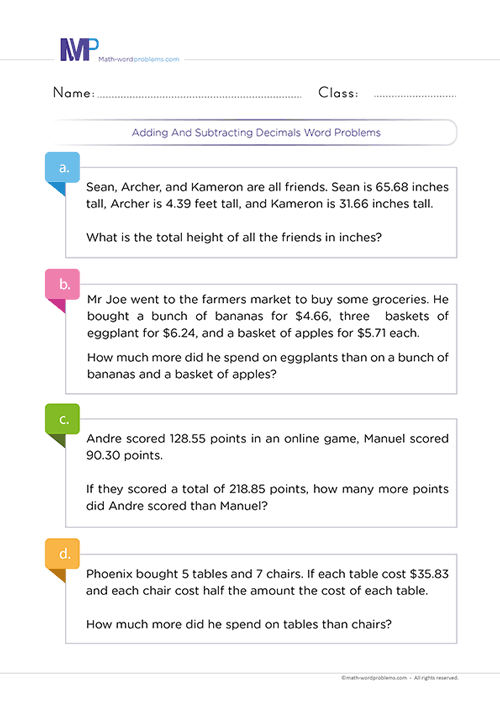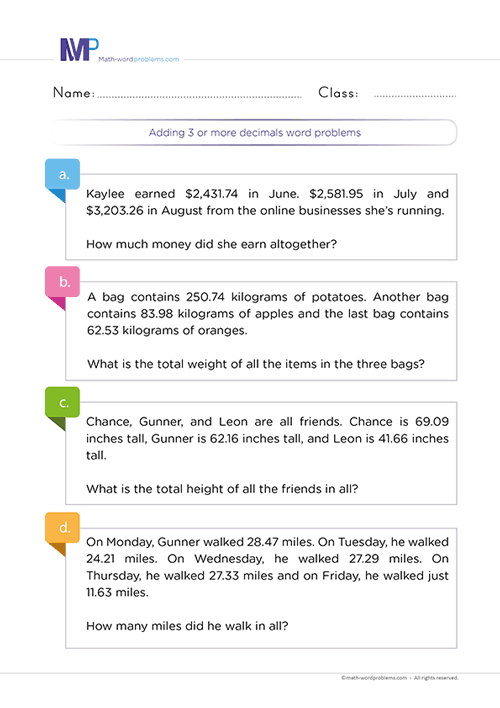 How to add and subtract decimals word problems
How to add and subtract decimals word problems
Here is a fantastic resource with steps on how to add and subtract decimals word problems. With our captivating and well-designed decimal problems, we hope to motivate kids to overcome the challenges of adding and subtracting decimals problems. Some of these challenges include: being too lazy to read long problems, having difficulty reading and understanding words in a problem, and many more.
In line with designing interesting decimals addition and subtraction word problems, we will equally include fun strategies on how to add and subtract decimals word problems enjoyably. Equally, with this strategy, kids will easily understand any problem type/structure/statement in any complex word problem and be able to come out with a solvable maths equation, leading to an accurate answer.
Steps on how to perform addition and subtraction of decimals word problems
When kids go through these enriching steps on how to perform addition and subtraction of decimals word problems, they will be excited and eager to solve any complex word problem they come across.
However, kids will gain mastery of the formula for solving mathematical word problems on addition and subtraction of decimals effortlessly. In addition, your kids' mathematical skills in tackling math word problems on addition and subtraction of decimals will significantly improve.
Besides, we will include some fantastic and fun examples below with steps on how to add and subtract decimals word problems.
Step 1: IDENTIFY THE PROBLEM
To identify the problem, read the problem very carefully and highlight facts such as numbers, important keywords, and what the problem wants you to solve.
- Firstly, when we talk about the addition of decimals word problem, these are the most important keywords you’ll come across: add, plus, more, total, increase, together/altogether, combined, sum, grow, join, both, etc.
- Secondly, suppose it is subtracting decimal numbers word problems. In that case, you will encounter the following keywords in the word problem: - less, minus, take away, left, decrease, difference, fewer, deduct, remain, change, how many more, leftover, less than, how much longer/shorter, how much more, fewer than, discount, etc.
- ***One key Element for learners to understand is that they should not always rely on keywords alone. That is to say; the same keyword can have different meanings in different word problems.
- For this reason, we reiterate on the importance of reading the question very carefully to understand the situation that the word problem is describing, then figure out exactly which operation to use***
Step 2: STRATEGIZE AND DETERMINE THE OPERATIONS
How will you solve or tackle the problem?
One key thing you should remember is that each word problem may require a different format. Hence, the key points below will enable young math learners to tackle any format however it comes.
- First, the keyword in the word problem will help clarify the operation that you need to carry out.
- On the other hand, know that you must not rely merely on keywords. Instead, try to understand the situation that the problem is describing.
- After knowing which operation you will perform, construct short expressions/sentences representing the given word problem. This visual representation of the most vital information will make it easier to solve the word problem.
Step 3: SET UP A NUMBER SENTENCE AND AN EQUATION
- After knowing which operation to perform, construct short phrases to represent the given word problem. This visual representation of the most vital information makes it easier to solve the word problem.
- Then, write down a numerical equation representing the information given in the word problem.
Here, you have to write down a numerical equation representing the information in the word problem.
Step 4: SOLVE THE PROBLEM
After writing down the math problem (numerical equation), you can solve the problem using any addition and subtraction method of your choice, preferably the column method.
Add the decimal values by arranging the decimal point to line up. As well as using zeros as place value holders, if need be, to solve the word problem. Additionally, don’t forget to attach the unit of measurement to the final result.
Step 5: VERIFY YOUR ANSWER
Finally, check your work to make sure that your answer is correct. For instance, estimate the answer and see if it is close to what you expected. However, if the answer is not what you expected, go back to step one and start all over again.
Examples on how to add and subtract decimals word problems
Example one: How to subtract decimals word problems.
Step 1:First, the important numbers here are 90.3 and 25.9. The keyword(s) found in the word problem is “how much more.”
Step 2:Next, ask yourself, “How can I solve this problem?” You see that the keyword found in the word problem calls for a subtraction operation.
Step 3:Then, construct short phrases to represent the given word problem and write down a numerical equation that represents the information in the word problem.
- Weight of the basket of cherries = 90.3kg
- Weight of the basket of apples = 25.9kg
- Therefore, how much more the basket of cherries weighs than apples = Weight of the basket of cherries - Weight of the basket of apples.
90.23kg - 25.96kg =?
Step 4: From step 3 above, stack the values in the equation you formed above so that the decimal point line up in the addends and sum. Also, use zeros as place value holders to solve the word problem. Furthermore, do not forget to add the unit of measurement to the final answer.
So, the basket of cherries weighs 64.40 kilograms more than the basket of apples.
Step 5:Finally, check your work to ensure your answer is correct. For example, estimate the answer and see if it is close to what you expected. However, if the answer is not what you expected, go back to step one and start all over again.
Example two: How to add decimals word problems.
Step 1: First, the important numbers here are 21.96, 253.0, 400.8, and 98.54. The keyword(s) found in the word problem is “how many.”
Step 2:Next, ask yourself, “How can I solve this problem?” You see that from the situation the problem is describing, and the keyword found in the word problem calls for an addition operation.
Step 3: Then, construct short phrases to represent the given word problem and write down a numerical equation that represents the information in the word problem.
- Number of pages that she wrote on Wednesday = 21.96.
- Number of pages that she wrote on Thursday = 253.0.
- Number of pages that she wrote on Friday = 400.8.
- Number of pages that she wrote on Saturday = 98.54.
- Therefore, the total number of pages that she has written so far = the number of pages that she wrote on Wednesday + the number of pages that she wrote on Thursday + the number of pages that she wrote on Friday + the number of pages that she wrote on Saturday.
21.96 + 253.0 + 400.8 + 98.54 = ?
Step 4: From step 3 above, stack the values in the equation you formed above so that the decimal point line up in the addends and sum. As well as using zeros as place value holders, if need be, to solve the word problem. Always remember to add the unit of measurement to your final result.
Finally, remember always to include the unit of measurement in your final answer.
Using the long multiplication method, we have
So, she has written 774.30 pages so far.
Step 5: Finally, check your work to ensure your answer is correct. For example, estimate the answer and see if it is close to what you expected. However, if the answer is not what you expected, go back to step one and start all over again.





